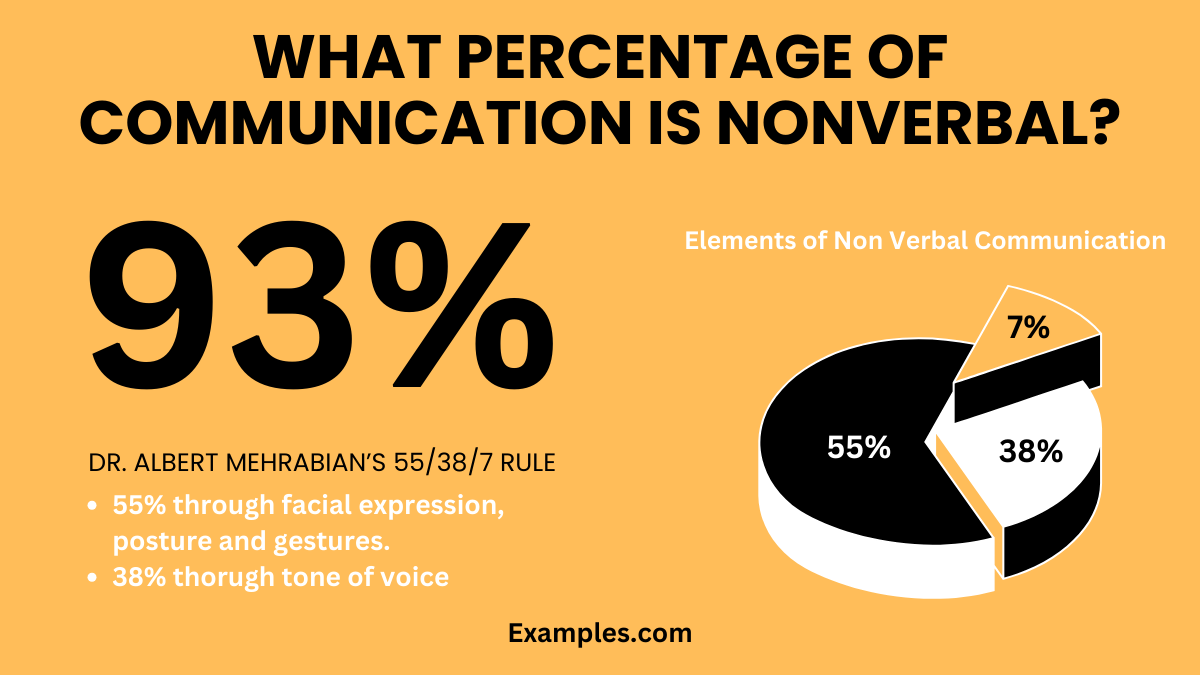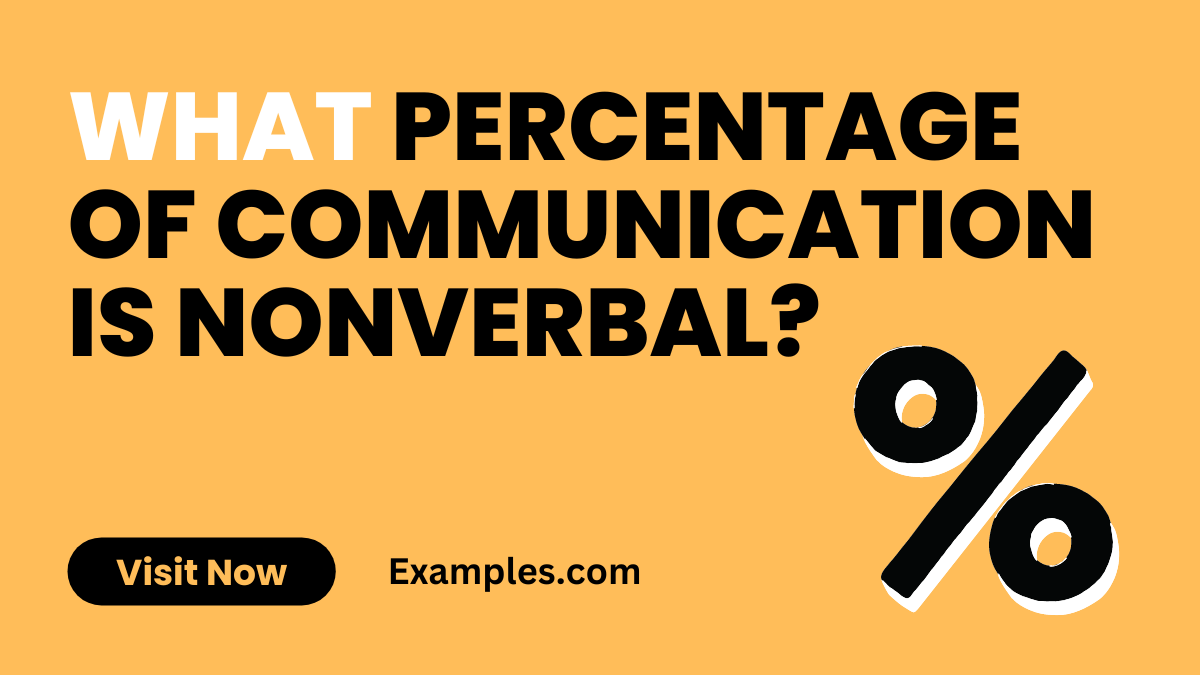What Percentage of Communication is Nonverbal?
Communication is a multifaceted process involving more than just the words we speak. A significant portion of communication is nonverbal, encompassing gestures, body language, facial expressions, and tone of voice. Understanding the percentage of communication that is nonverbal, along with its history, is crucial for effective interpersonal interactions.
What Percentage of Communication is Nonverbal?

The often-cited statistic is that 93% of communication is nonverbal. This figure comes from the work of Dr. Albert Mehrabian, a Professor Emeritus of Psychology at UCLA. Mehrabian conducted several studies on communication and is best known for his publications on the relative importance of verbal and nonverbal messages. His findings are frequently summarized with the formula 7-38-55, where 7% of the message is conveyed through words, 38% through tone of voice, and 55% through body language.
However, it’s crucial to understand the context of Mehrabian’s research. His studies, conducted in the 1960s, specifically examined the communication of feelings and attitudes. Therefore, the 93% figure is relevant primarily in situations where someone is communicating their feelings or attitudes and the spoken words are ambiguous or incongruent with the tone of voice and body language.
Understanding the 55/38/7 Formula
- 55% Nonverbal Behavior (Body Language): According to this formula, 55% of communication is conveyed through nonverbal behaviors. This includes facial expressions, posture, gestures, and general body language. These nonverbal cues are powerful in conveying emotions and attitudes, often conveying more meaning than the spoken words.
- 38% Tone of Voice: The formula asserts that 38% of communication is relayed through the tone of voice. This includes the pitch, pace, volume, and inflection of the voice. The way something is said often impacts the message more significantly than the actual words used.
- 7% Spoken Words: Only 7% of the communication process is attributed to the spoken words themselves. This highlights that the actual words we use are less significant in conveying emotions and attitudes compared to nonverbal cues and tone of voice.
Applications and Misinterpretations
- Emotional Communication: It’s important to note that the 55/38/7 formula applies primarily to situations where emotions and attitudes are being communicated. In such contexts, nonverbal cues and tone of voice play a dominant role.
- Misinterpretations: The formula is sometimes misinterpreted or overgeneralized. It doesn’t imply that words are not important; rather, it emphasizes the importance of nonverbal cues and tone in conveying emotions and attitudes.
- Cultural Variations: Nonverbal communication can vary significantly across different cultures, affecting the applicability of the 55/38/7 distribution in global contexts.
Historical Context of Nonverbal Communication
The study of nonverbal communication has roots in various fields including psychology, anthropology, and sociology, with significant advancements in the 20th century:
- Early 20th Century: Researchers began recognizing nonverbal behaviors, though the focus was predominantly on verbal communication.
- The 1950s and 1960s: This era marked a shift, with scholars like Ray Birdwhistell and Albert Mehrabian delving deeper into the nonverbal aspects. Birdwhistell introduced “kinesics” – the study of body motion communication.
- The 1970s and Beyond: Nonverbal communication gained substantial academic interest. Studies expanded into areas like facial expressions, with psychologists like Paul Ekman leading the way in understanding microexpressions and their link to emotions.
Modern Understanding of Nonverbal Communication
Today, nonverbal communication is recognized as an integral part of how we interact. It plays a vital role in:
- Emphasizing Verbal Messages: Nonverbal cues can reinforce what is said verbally.
- Conveying Emotions: Facial expressions and body language often reveal true feelings.
- Facilitating Social Interaction: Nonverbal behaviors help in managing turn-taking during conversations.
- Influencing Persuasion: Effective use of nonverbal cues can enhance persuasive efforts.
Importance of Nonverbal in Communication
Nonverbal communication plays a vital role in how we convey and interpret messages. It encompasses a range of behaviors and actions beyond spoken words. Understanding its significance can enhance interpersonal relationships and professional interactions. Here are key points detailing the importance of nonverbal communication:
- Conveys Emotional Information: Nonverbal cues like facial expressions, body language, and tone of voice are crucial in conveying emotions. They can express feelings such as happiness, anger, or discomfort, often more accurately than words.
- Supports Verbal Communication: Nonverbal behavior can reinforce or contradict what is said verbally. For example, a nod while saying “yes” reinforces the message, while a shake of the head can contradict a verbal agreement.
- Regulates Conversations: Nonverbal cues like eye contact and gestures play a role in regulating the flow of conversations. They signal when it’s someone else’s turn to speak or indicate when someone is not yet finished speaking.
- Establishes Relationship Dynamics: Body language can indicate the nature of relationships. For instance, the distance we maintain, the way we face someone, or our level of eye contact can signal intimacy, authority, or aggression.
- Facilitates Understanding in Multilingual Environments: In settings where language barriers exist, nonverbal communication becomes a universal means of conveying basic messages and emotions.
- Reflects Cultural Values: Nonverbal behaviors are deeply rooted in cultural backgrounds. Understanding these can be key in cross-cultural communication, preventing misunderstandings and fostering respect.
- Influences Persuasion and Negotiation: Successful negotiators and persuaders are often adept at reading and using nonverbal cues. These cues can be used to build trust, demonstrate assertiveness, or convey sincerity.
- Indicates Deception or Truthfulness: Nonverbal cues can sometimes indicate whether a person is being truthful or deceptive, as some involuntary reactions can be hard to control.
- Affects First Impressions: The initial impression we make often depends heavily on nonverbal elements like appearance, posture, and facial expressions, which can set the tone for future interactions.
- Enhances Clarity in Communication: Nonverbal cues can add clarity to a verbal message, reducing misunderstandings. For example, pointing to an object while talking about it can help ensure the listener understands the reference.
In summary, nonverbal communication is a powerful and integral part of how we interact with others. Its effective use and interpretation are essential for successful communication in both personal and professional settings.



